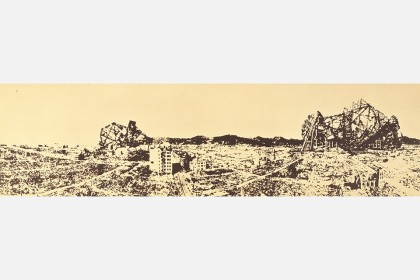
Re-Ruined Hiroshima
The desolate panorama invites contemplation of the violence that inscribes Japanese, if not global, landscapes and architecture. The fragments here are former spaces of inhabitation incinerated by an atomic bomb—wreckage that Isozaki called “dead architecture.” Like his contemporaries, he sought to remove hierarchies and ideological impediments from the built environment; here the architect merged scenes of annihilation with images of broken buildings that once connoted institutional and economic power. For him, the restitution of the city, and, by extension, of society, required “the operation of the imagination.” Isozaki’s vision is both history lesson and portentous tale of what might become of us if we are not checked. The city’s remnants have buckled into its already degraded ground; architecture thus records acts of destruction and the collective histories of failed geopolitics, destructive technologies, and fragile societies in collapse.
Cited from New York: The Museum of Modern Art, “MoMA Highlights: 375 Works from The Museum of Modern Art” p250 – 251
MoMA collection: https://www.moma.org/collection/works/816

